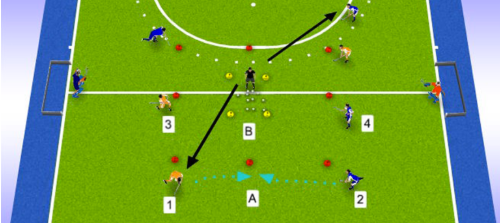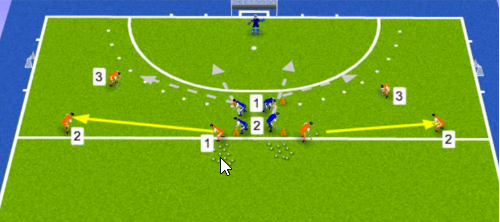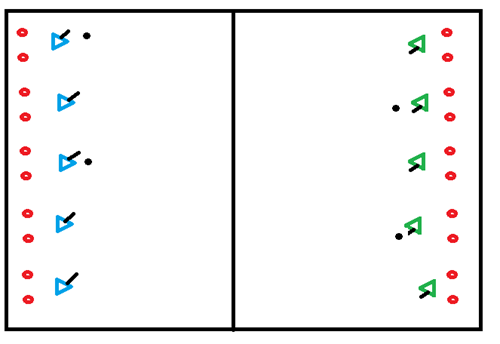Hockey drills for technique attack / offense
- Player 1 plays the ball to player 2 and player 1 runs on
- Player 2 bounces the ball back to player 1,
- Player 1 lines up the ball between the pawns (the player himself will not run in the "pawn box".
- Player 1 finishes the ball on goal.
- Player 1 plays the ball to Player 2 and runs towards the goal,
- Player 2 plays the ball to player 3,
- Player 3 runs up to the pawn and gives a hard flick towards the 2nd post,
- Player 1 tips the ball into the goal.
- First pass wide
- players moves the ball inside other attacker move outside
- 2 options walking inside passing outside
- Player 1 runs with the ball to the head circle and hits the goal
- Player 4 plays the ball to the left where player 2 and defender 1 come running in (2v1)
- Player 4 plays the ball to the right where player 3 and defender 2 come running in (3v2)
- Player 4 runs with a ball into the circle and plays off the attack (4v2)
- Player 1 and 2 are defenders
- Player 3 and 4 are attackers
- Player 3 runs with a ball to player 1 and tries to get past player 1.
- The same happens on the other side.
- There are at least 2 teams
- The field is the 23, from marker to other marker
- You may shoot on goal from any position in the field if not dangerous
- After 2 goals by the same team the losing team switches (After 3 wins the winning team switches)
- Set up the exercise and where the ball is played to the team-mate it goes through the alley.
- At the end of the exercise the ball carrier can score on goal.
- After the exercise, the players walk along the outside back to the start.
- Increase the distance between them
- Make the street narrower and narrower
- change the starting position after a while

OrganizationField
: half field
Implementation
General
- Play direction of the game
- Goals in the middle of the field to stimulate awareness of the context of the game (from where do I defend, where do I score?).
- 1:1 : the trainer plays a ball to Orange 1 or Blue 2. Defender's goal is to prevent a goal and score himself.
- 2:1 : The trainer plays a ball to Orange 1 or Blue 2. When Orange 1 gets the ball, Orange 3 can join in the playing field of Orange 1
- Orange 1 and 2 play a 2:1 on Blue 4 (same if Orange 3 gets the ball (Section B)).
- 2:2 : Same as 2:1, but if Blue 2 gets the ball, Blue 4 may join the attack in the section of Orange 1 (Section A).
Tips on ball possession - Perform a feint when passing.
- Cut in after the passing action; protect the ball from the defender.
Tips on non-ball possession
- Find your opponent as quickly as possible.
- Keep your stick on the ball.
- Keep the opponent in front of you (on the forehand).
- ps changeover
At loss of ball:
- Put direct pressure on the ball handler, cut the shortest path to the goal.
On winning the ball:
- Perform a quick action/goal attempt towards goals.
- Making it easier
- Change the start location regularly.
Make it more difficult
- Vary the speed of throw.

Explanation
3 (4) against 2 + goalkeeper
OrganisationField
: demarcated space (on half a field)
General
- The form starts when blue 1 passes to orange 1.
- Orange 1, 2 and 3 ( possibly 4) try to score in the goal.
- Blue 1 and 2 try, by working together, to take over possession of the ball on their strong side and then to score in one of the little goals on the centre field (circle size about 3 metres).
The form stops when:
- Orange scores in the goal.
- Blue scores in the conversion in one of the little goals on the half way line.
- The ball goes over the back line.
Exceptions:
- Ball over the sideline is a normal strike.
- Foul is a normal free hit.
Tips on ball possession
- Look before taking the ball (pre-scanning) and recognise space.
- Take free hits and hits as quickly as possible.
- Use push passes.
Tips on non-ball possession
- Work together (cover each other's backs), give pressure on the ball, keep the ball on your defensive forehand side (fake space).
- Force a pass to the back or force a pass wide; this is better than a deep pass.
- Make sure you are always between the ball and your own goal
Switching tips
- On losing the ball:
- Keep pressure on the ball straight away
- Get between the ball and your own goal as quickly as possible and help your team-mate
- On winning the ball:
- Look for the free space
- Play a confident pass or accelerate strongly yourself.
- Make it easier
- Vary the method of passing (e.g. push pass) or initial pass to another player.
- Make it more difficult
- Increase Pressure:
- Who scores the most goals in 10 ball starts);
- can Orange 1,2,3 score within 30 sec.
- Increase Pressure:

Goal: Build up by moving the ball.
Instruction:
- 1 starts with the ball and plays it to 2
- 2 plays the ball back to 1
- 1 plays the ball to 3
- 3 plays the ball to 4
- 4 starts the attack and may choose how he does this
Point of attention: The defenders try to get rid of the ball as quickly and skillfully as possible
- Two teams with substitutes, substitutions are made when a goal is scored.
- Each person defends a goal, on each field there are 5 goals,
- so there are also 5 people who defend these goals.
- If a goal is scored in your goal, you have to sit on the sidelines and you become a substitute.
- A new player (substitute) from the side enters the field and will defend the goal.
- If a goal is scored, it is 1 point.
- The team that has the most points at the end of the game is the winner.

Overplaying to score
- Two players continuously play the ball over
- until one of them is so close to the goal
- that he can score in the goal.
Variation 2-1 situation:
- Under pressure from the defender, the attackers must now play together and try to score.
- The defender can score a point by conquering the ball and then dribbling over the dead ball line.
- This is the short side without a goal.







